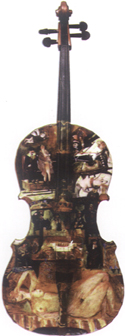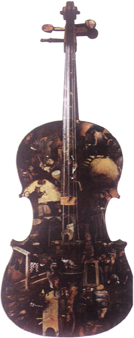Konstantin Bessmertny is a figurative painter.
The History of Twentieth century art shows the almost indestructible connection with figuration on the part of the artists. It has been resistant to everything, even to the incursions of abstractionism and conceptualism. Francis Bacon, Lucien Freud, David Hockney and Frank Auerbach, among others, prior to neo-figuration of the 1980s, retained their loyalty to it.
Artists continued with another tradition that expressionism, in many cases illustrative, such as that of Breughel the Elder, Bosch, Hogarth, Goya, Chagall, Soutine and Kirchner have bequeathed to us.
His figuration, somehow illustrative, sometimes assumes different dimensions, from those of Paula Rego, Mario Botas and John Bellany, all of whom have their own 'dimensions'.
On the canvases of the Russian painter, perversion is not seen as being cruel. Instead, it is full of irony, sarcasm and wonder, the latter being obtained through illogical imagery and the almost absurd: "To find sense in the absurd is what the painter finally aspires to; to the inhuman" (J. F. Lyotard) is evident in many of the forms he creates.
Like Proust his thoughts run rapidly through the brush and the painting-knife, tools which delineate transfigured memories; those dwell in our inner soul, reminding us of objects, people, the history and the tales...
On his canvases there is a hint of a return to infancy, an unveiling of the deepest, and doors open to a dream composed of questions.
Lost time is found in another time and in another place (strange but simultaneously understood).
As a child, Konstantin Bessmertny whose talent manifested itself at four years old and has been developed since the age of ten, told stories to his play friends by drawing. These drawings were certainly malicious, as are, his drawings, today. He explained to his friends the meaning of what he had 'written', causing unending laughter.
Today, the figures and objects he projects into his paintings are memories, wishes, sensualities, risqué thoughts, futilities, teasings and other serious attributes of life and human condition.
Thus, his canvases "[...] are not parodies, in any sense [...]."1 Remembering Eça de Queirós and rewriting one of his most famous sentences, one could say that under the cape of fantasy, the nudity of truth will show. One must discover it in the apparent chaos.
Konstantin Bessmertny enjoys illustrating; however he is not an illustrator of text narratives. The personages, the objects, the beasts which dwell in his dramas, so often resembling coloured cartoons, constitute a type of Gestalt of his system. In its form of pre-narrative he presents the stage of his theatre, with the actors at the ready, prepared for the masque and antimasque as one remembers in one particular Ben Johnson play. 2
This is nothing to do with tragedy, however; the painter is not fond of tragedy. "Breughel is better than Bosch (whom, notwithstanding, he greatly admires) because his works are less tragic." "Dubuffet is big, funny."
Somewhere between the paradoxes of the logical and the absurd, of the serious and the amusing, of tranquillity and agitation, lies the peculiarity of the painter.
Accompanying this stands the academic and technical 'machine' of such things as the handling of the tints in voluptuous colours and of the tools which the painter uses with such energy.
On the surface of the canvas, Konstantin infiltrates a language where the 'inhuman' is always present, because in the end "[...] art is above all about being human. 3

Cello II — front.
KONSTANTIN BESSMERTNY (°1964).
1996. Oil on wood.
Private Collection, Macao.

Cello I — front.
KONSTANTIN BESSMERTNY (°1964).
1996. Oil on wood.
Private Collection, Macao.
In: Força e Fraquezas/Strengths & Weaknesses: Konstantin Bessmertny, Macau, [Exhibition Catalogue /Salão de Exposições Comendador Ho Yin-Clube Militar (Military Club): Novembro de 1996 [November 1996]], ill. [n. n.].
Indeed the inhuman in Konstantin is the measure of his humanity
Revised reprint from:
MATIAS, Maria Margarida L. G. Marques, Konstantin Bessmertnyi — the Sense of the Human, in "Konstantin Bessmertny", [Exhibition Catalogue], Instituto Cultural de Macau - Missão de Macau em Lisboa, 1955, pp. 4-5.
NOTES
1 HAYASHI, Yoko, About Jasumasa Morimura, in "Art in Japan Today: 1985-1995", [Exhibition Catalogue] Tokyo, Museum of Contemporary Art, 1955.
2 Neptune's Triumph for the Return of Albion.
3 KEITH, Patrick, John Bellany: A long night's journey into day, in "Contemporary Art", 1(1) 1992, p. 12.
* MA in Germanic Philology from the Faculdade de Letras (Faculty of Arts) of the Universidade de Lisboa (University of Lisbon), Lisbon. She is a professional museum curator and an art historian. She is currently an appraiser of the Missão de Macau em Lisboa, Lisbon.
start p. 157
end p.